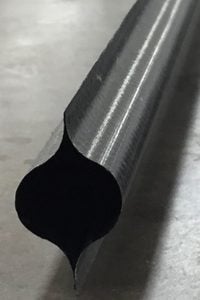Sometimes big things come in small packages, and the new thin but strong materials the University of Central Florida is helping NASA develop are no exception.
These materials, known as thin-ply composites, are as thin as carpenter’s measuring tape but strong enough to support satellite payloads, such as solar sails for solar-powered space travel, or serve as supports for large spacecraft.
And like measuring tape, thin-ply composite structures can be rolled up, compacted and stored for long periods until they are needed to be deployed.
The thin composites are made from woven fibers of materials such as carbon, graphene and polymers, and their strength comes from slight curves along their edges that allow them to support weight rather than bending backward.
The work is funded through a recently announced NASA Small Business Technology Transfer program in which Purdue University-affiliated software company AnalySwift is the lead and UCF is the primary research institution.

“Thin-ply composites offer significant gains in performance over traditional metallic materials for constructing deployable spacecraft structures,” says Kawai Kwok, an assistant professor in UCF’s Department of Mechanical and Aerospace Engineering who is leading the research.
“The extreme thinness and the high failure strain limit of thin-ply composites results in folding curvatures that far exceed the current capability,” he says. “They are both volume and mass efficient and can be manufactured at low cost with readily available materials and commercial processes,” he says.
Kwok and his Structures and Materials Design Lab will use experimental and computational methodologies they’ve developed to characterize and model the performance of thin-ply composites and polymers designed for space environments under repeated use and long, compressed storage periods.

Kwok says the experimental data, theories and companion software developed from this research could be applied to booms, sails, panels, reflectors and more for satellites, as well as to lightweight structures for landers, rovers and solar arrays for NASA missions, and future aircraft with compact and vertical launching capabilities.
AnalySwift chose to work with UCF because of Kwok’s extensive experience with researching thin-ply composite materials, including for NASA, says Allan Wood, president and CEO of AnalySwift.
“Professor Kawai Kwok has been collaborating with NASA on this problem, and AnalySwift is pleased to partner with UCF as the research institution on this project,” Wood says.
AnalySwift and UCF are also partnering with Purdue University, which will lead research code development, as well as run simulations needed for model verification and validation under the direction of Wenbin Yu, a professor in Purdue’s School of Aeronautics and Astronautics.
“There are currently no validated and reliable characterization and modeling methods and tools for this type of work that considers such extreme conditions and past loading histories,” Yu says. “Without reliable prediction and characterization capabilities, additional tests are often needed to circumvent any uncertainties in performance of the final design, consequently slowing down the technology development and delivery.”
Kwok received his doctorate in aerospace engineering from the California Institute of Technology. He joined UCF’s Department of Mechanical and Aerospace Engineering, part of UCF’s College of Engineering and Computer Science, in 2017.




